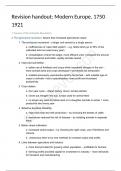Other
Study/ Revision notes_CAIE AS-level History 9489: EUROPEAN HISTORY: THE INDUSTRIAL REVOLUTION IN BRITAIN, 1750–1850
- Course
- Institution
- Book
These revision notes follow the updated CAIE A-level History 9489 syllabus and scheme of work for for Paper 1/2: EUROPEAN HISTORY: THE INDUSTRIAL REVOLUTION IN BRITAIN, 1750–1850 ). Easy to follow, clear and very detailed notes that cover all the core content topics, with exam guidance, structur...
[Show more]




